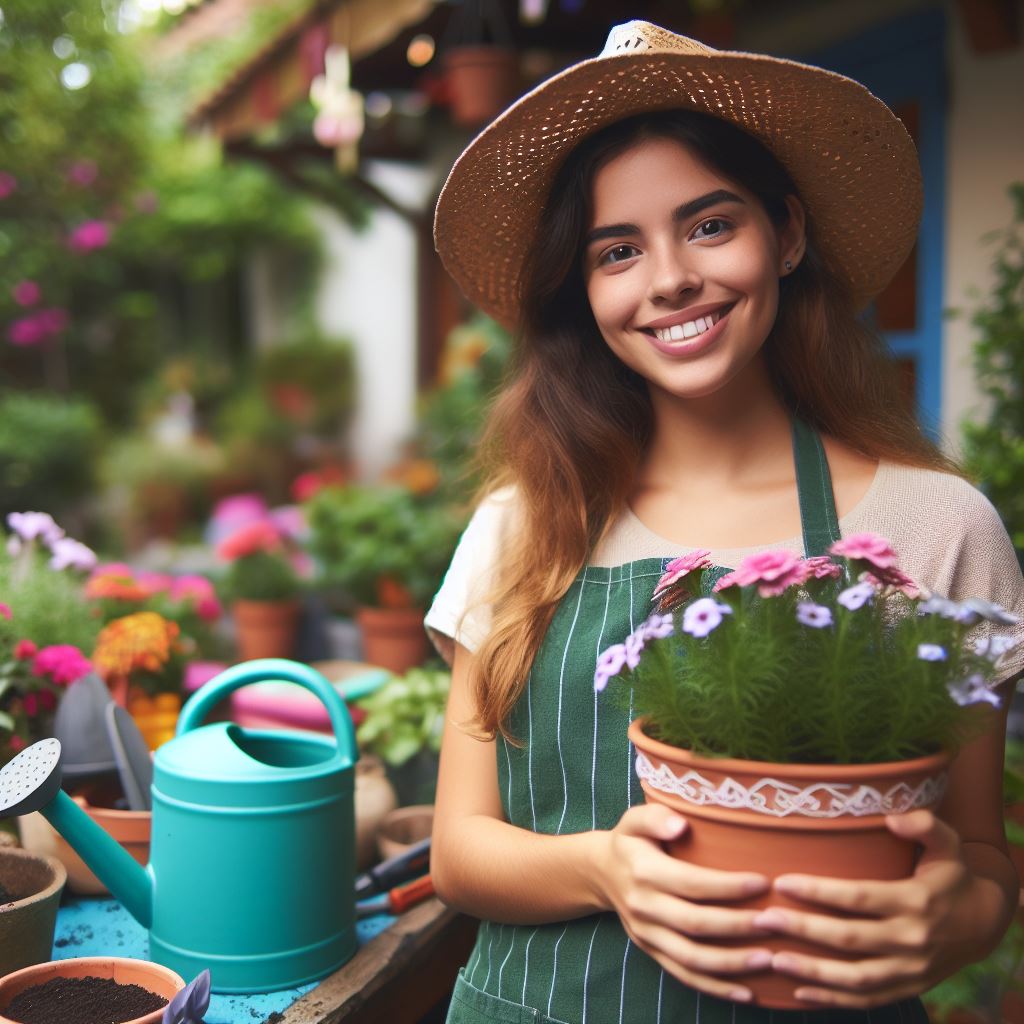Introduction
Gardens are sanctuaries of life, teeming with vibrant flora and fauna.
Pest control plays a pivotal role in maintaining the health and vitality of these green spaces.
In the past, conventional pest control methods often relied on harmful chemicals, posing risks to both the environment and human health.
However, there has been a notable shift towards eco-friendly approaches in recent years.
The importance of pest control in gardens cannot be overstated.
Pests, if left unchecked, can wreak havoc, causing damage to crops, flowers, and other plants.
This not only affects the aesthetic appeal of the garden but also disrupts the delicate ecological balance.
Moreover, certain pests can transmit diseases, posing additional threats to plant life and even human well-being.
Recognizing these challenges, gardeners are increasingly turning to eco-friendly pest control methods.
These methods prioritize sustainability and environmental stewardship.
By utilizing natural predators, such as ladybugs or praying mantises, or employing organic pesticides derived from plant extracts, gardeners can effectively manage pest populations without compromising the ecosystem’s integrity.
In this section, we will explore the various eco-friendly pest control techniques available to gardeners.
From companion planting and biological controls to homemade remedies and cultural practices, there are numerous strategies that promote harmony between humans, plants, and pests.
By embracing these eco-conscious approaches, we can cultivate thriving gardens that flourish in harmony with nature.
Understanding Eco-Friendly Pest Control
Eco-friendly pest control refers to the use of natural and sustainable methods to manage pests in gardens.
Rather than relying on harmful chemicals, these methods focus on preserving the environment and minimizing harm to beneficial organisms.
Principles of Eco-Friendly Pest Control
- Prevention: The first principle is to prevent pest infestations by creating a healthy garden ecosystem. This includes maintaining soil fertility, choosing pest-resistant plants, and promoting biodiversity.
- Monitoring: Regularly inspecting plants for signs of pests helps identify problems early on. By catching infestations in their early stages, you can intervene before they become widespread and more challenging to control.
- Biological Control: Encouraging natural predators and beneficial insects is essential in eco-friendly pest control. Ladybugs, lacewings, and spiders are all examples of insects that feed on pests and help keep their populations in check.
- Cultural Methods: Practicing good garden hygiene and cultural techniques can prevent pest problems. This includes removing plant debris, rotating crops, and avoiding over-fertilization, which can attract pests.
- Mechanical Control: Physically removing pests by hand or using traps is an effective and eco-friendly method. This approach avoids the use of chemicals and is especially useful for larger pests like slugs and snails.
Benefits of Using Eco-Friendly Methods in Gardens
- Reduced Environmental Impact: Eco-friendly pest control methods minimize the use of pesticides and their harmful effects on the soil, water, and air.
- Preservation of Beneficial Organisms: Unlike chemical pesticides, eco-friendly methods do not harm beneficial insects, birds, or wildlife, allowing them to thrive and contribute to a healthy ecosystem.
- Safer for Humans and Pets: Chemical pesticides can pose health risks to humans and pets if exposed to them. Eco-friendly methods eliminate this concern, providing a safe environment for everyone.
- Sustainable Pest Management: Eco-friendly pest control focuses on long-term solutions rather than quick fixes. By addressing the root causes of pest problems, these methods provide sustainable and lasting results.
- Cost-Effective: While initially, some eco-friendly pest control techniques may require more effort and time, they can save money in the long run. Eliminating the need for expensive chemical pesticides reduces expenses associated with pest management.
Eco-friendly pest control practices you can adopt
Implementing eco-friendly pest control methods in your garden is not only beneficial for the environment, but it also enhances the overall health and aesthetics of your plants.
By understanding the principles and advantages of these methods, you can embrace a more sustainable approach to pest management.
Listed below are some eco-friendly pest control practices you can adopt:
- Introduce Beneficial Insects: Attract and release beneficial insects like ladybugs, praying mantis, or parasitic wasps to combat pests naturally.
- Companion Planting: Pairing pest-resistant plants with vulnerable ones can deter pests from infesting your garden.
- Natural Sprays: Prepare homemade organic sprays using ingredients like neem oil, garlic, or hot pepper to repel common garden pests.
- Organic Fertilizers: Avoid chemical fertilizers, which can attract pests, and instead opt for organic alternatives to nourish your plants.
- Mulching: Mulch your garden beds to retain moisture, suppress weeds, and create a barrier that deters pests from reaching your plants.
In short, eco-friendly pest control offers a sustainable and environmentally conscious approach to managing pests in gardens.
By implementing these methods, you not only protect the ecosystem but also create a healthy and thriving garden for you and your plants to enjoy.
Identification and Prevention of Garden Pests
Common garden pests and their impact on plants
- Aphids: These tiny insects suck the sap from plants, causing leaves to curl and distort.
- Slugs and snails: These slimy creatures eat leaves and stems, leaving holes and slime trails.
- Caterpillars: These larvae of butterflies and moths can devour whole plants if left unchecked.
- Scales: These pests attach themselves to plants and feed by sucking sap, causing leaves to turn yellow.
- Whiteflies: These small, flying insects swarm around plants, sucking sap and spreading diseases.
Techniques for identifying different types of pests
- Visual inspection: Regularly examine plants for signs of pests, such as chewed leaves or discolored areas.
- Trap monitoring: Set up traps to catch and identify specific pests, like sticky traps for flying insects.
- Use of identification guides: Consult books or online resources to compare pest characteristics and identify them accurately.
- Seek professional help: If unsure about pest identification, consult a local garden center or pest control expert.
Prevention measures to minimize pest infestations
- Plant selection: Choose pest-resistant varieties and diversify plant species to reduce pest attraction.
- Proper sanitation: Remove fallen leaves, weeds, and dead plant material to eliminate hiding places for pests.
- Crop rotation: Rotate crops annually to disrupt the life cycle of pests and prevent them from building up in soil.
- Natural predators: Encourage beneficial insects like ladybugs and lacewings to prey on garden pests.
- Physical barriers: Install nets, fences, or row covers to physically prevent pests from accessing plants.
- Mulching: Use organic mulch to discourage pests and create a protective barrier around plant roots.
- Regular watering and fertilization: Maintain healthy plant growth to resist pest infestations.
- Companion planting: Interplant flowers and herbs that repel pests, such as marigolds and basil, among vegetables.
By identifying common garden pests and understanding their impact on plants, you can effectively protect your garden.
Implementing various techniques for pest identification will allow you to take prompt action against specific pests.
Prevention measures, such as plant selection and natural predators, can significantly minimize pest infestations.
Don’t forget to regularly monitor your garden, as early detection and prevention are key to maintaining an eco-friendly environment.
Read: Preventing Garden Pests Naturally
Natural Predators and Beneficial Insects
Introduction to natural predators and their role in pest control:
- Natural predators are organisms that naturally feed on pests, helping control their population.
- They play a vital role in maintaining the ecological balance of gardens.
- Instead of relying on chemicals, promoting natural predators is an eco-friendly approach to pest control.
- These predators reduce the need for harmful pesticides, ensuring a safer environment for humans and other creatures.
Common beneficial insects and their benefits for gardens
- Ladybugs: They feed on aphids, mites, and other soft-bodied insects damaging plants.
- Praying Mantises: They devour a variety of pests like flies, mosquitoes, and caterpillars.
- Ground Beetles: They prey on slugs, snails, and other crawling insects harmful to plants.
- Green Lacewings: Their larvae eat aphids, mealybugs, and spider mites.
- Predatory Wasps: They assist in controlling caterpillars, flies, and beetle larvae.
- Hoverflies: Their larvae consume aphids and help in pollination by feeding on flower nectar.
Ways to attract and promote beneficial insects in the garden
- Planting a diverse range of flowering plants attracts beneficial insects to the garden.
- Include plants like dill, fennel, and parsley to attract beneficial wasps that prey on pests.
- Create areas with rocks, logs, or dense vegetation to provide hiding places and nesting sites for beneficial insects.
- Avoid using chemical pesticides, as they may harm or repel beneficial insects.
- Choose organic and pesticide-free gardening methods to create a favorable environment for these insects.
- Encourage a healthy garden ecosystem by maintaining proper soil fertility and watering practices.
- Introduce beneficial insects to the garden by purchasing them from specialized suppliers.
- Use companion planting techniques to attract beneficial insects, like marigolds to deter pests.
- Install birdhouses and bird feeders to attract birds that feed on insects.
- Create a small water source like a birdbath or shallow dish to provide drinking water for beneficial insects.
In fact, natural predators and beneficial insects are vital components of eco-friendly pest control in gardens.
By understanding their roles, benefits, and ways to attract them, gardeners can significantly reduce pest populations without resorting to harmful chemicals.
Read: Herbal Mixes to Protect Your Plants

Organic and Homemade Pest Control Solutions
Overview of organic pest control products available in the market
- Organic pest control products are becoming increasingly popular in gardens.
- These products are made from natural ingredients and do not harm the environment.
- They are safe to use around children, pets, and beneficial insects like bees and butterflies.
- Organic pest control products come in various forms such as sprays, powders, and traps.
- They are effective in controlling a wide range of pests including aphids, caterpillars, and slugs.
- Many organic products also have additional benefits such as improving soil health and plant growth.
Homemade solutions using natural ingredients
- Apart from commercial organic pest control products, homemade solutions can be effective too.
- These solutions are cost-effective and can be made using readily available natural ingredients.
- Garlic and chili pepper spray: Mix crushed garlic and chili peppers with water and spray on plants.
- Neem oil spray: Neem oil is a natural pesticide that repels insects. Dilute it with water and spray on plants.
- Soap spray: Mix mild liquid soap with water and spray on plants to kill pests like aphids and mites.
Step-by-step guide for making and using organic pest control sprays
- Choose the right organic pest control spray based on the type of pest and plant.
- Gather the necessary ingredients like garlic, chili peppers, neem oil, and liquid soap.
- Follow the recipe and measurements for making the organic pest control spray.
- Prepare a spray bottle and fill it with the homemade solution.
- Test the spray on a small portion of the plant to ensure it doesn’t cause any damage.
- Once satisfied, spray the solution on the affected plants, focusing on areas with pests.
- Reapply the spray as needed, especially after rain or heavy watering.
- Monitor the plants for any signs of improvement or recurring pest issues.
- Adjust the homemade spray recipe or try alternative organic solutions if needed.
- Enjoy a garden free from harmful pests while promoting a healthy and eco-friendly environment.
In essence, organic and homemade pest control solutions provide a safe and effective way to manage pests in gardens.
These products are environmentally friendly, easy to make, and economical.
By utilizing organic pest control methods, gardeners can protect their plants without harming the ecosystem.
Moreover, homemade solutions allow individuals to have control over the ingredients used, ensuring the well-being of their plants.
Experimenting with different organic pest control methods can lead to finding the most suitable solution for each unique garden.
Transform Your Agribusiness
Unlock your farm's potential with expert advice tailored to your needs. Get actionable steps that drive real results.
Get StartedRead: Fighting Fungi: Organic Methods
Companion Planting
Companion planting is a gardening technique that involves planting different species of plants together in a way that benefits each other.
This method provides numerous advantages, especially when it comes to pest control.
By integrating specific plant combinations, gardeners can reduce the use of harmful chemicals and promote a healthy ecosystem.
There are several benefits to companion planting for pest control.
Firstly, certain plants emit odors or substances that repel pests, acting as a natural deterrent.
For example, marigolds produce a strong scent that repels aphids, nematodes, and other common garden pests.
Secondly, companion plants can attract beneficial insects that prey on pests. For instance, planting dill or fennel attracts ladybugs, which feed on aphids.
Implementing companion planting strategies in the garden is relatively simple.
First, familiarize yourself with the different plant combinations that work well together.
Some effective examples include planting basil near tomatoes to deter tomato hornworms or interplanting onions with carrots to repel carrot flies.
By selecting the right plant partners, you can create a harmonious ecosystem that naturally controls pests.
How to implement companion planting strategies in the garden
To apply companion planting, you need to plan the layout of your garden carefully.
Consider the specific pest issues you want to address and select companion plants accordingly.
Create a planting scheme where compatible plants are placed next to each other.
For example, you can plant chives or garlic alongside roses to ward off aphids.
The key is to find plant combinations that complement and support each other’s growth.
Additionally, incorporating diverse plant species in your garden is crucial for successful companion planting.
Monoculture, or growing only one type of plant, is not ideal as it allows pests to thrive.
By mixing different plants, you create a more complex environment that discourages pests from settling.
This biodiversity also attracts a wider range of beneficial insects, creating a natural balance in your garden.
Maintaining a healthy garden through proper watering, soil management, and regular monitoring is also essential for effective pest control.
Companion planting is not a guaranteed solution but rather a tool to assist in managing pests.
Regularly inspect your plants for signs of infestation and take necessary actions promptly, such as removing affected leaves or introducing natural predators.
In review, companion planting offers an eco-friendly approach to pest control in gardens.
By harnessing the natural properties of different plant species, gardeners can create a balanced ecosystem that minimizes the need for harmful chemicals.
The benefits include repelling pests, attracting beneficial insects, and promoting a diverse and healthy garden.
When implementing companion planting strategies, careful planning and regular maintenance are essential for success.
Embrace this sustainable practice and enjoy a beautiful, bountiful, and pest-free garden.
Read: Spring Planting Tips: What & When to Grow
Plant Health and Soil Management
Maintaining healthy plants and soil is crucial in effective pest control.
Here are some best practices and techniques:
The Importance of Healthy Plants and Soil in Pest Control
- Healthy plants are more resistant to pests and diseases, reducing the need for chemical interventions.
- Nutrient-rich soil provides plants with the necessary strength and vitality to withstand pest attacks.
- Well-maintained soil promotes beneficial organisms that can naturally combat pests.
Best Practices for Maintaining Plant Health
- Choose resistant plant varieties: Select plant species that are known for their resistance to common pests in your region.
- Maintain proper nutrition: Regularly fertilize your plants to ensure they receive adequate nutrients for optimal health.
- Water correctly: Avoid over and underwatering, as both can weaken plants and make them more susceptible to pests.
- Prune and remove diseased plants: Promptly remove infected plants to prevent the spread of pests and diseases.
- Implement crop rotation: Rotate plant families yearly to disrupt pest life cycles and reduce pest populations.
Soil Management Techniques to Deter Pests
- Use organic matter: Incorporate compost, manure, or organic fertilizers into the soil to improve its structure and promote nutrient cycling.
- Mulch application: Apply organic mulch around plants to conserve moisture, suppress weed growth, and deter certain pests.
- Encourage biodiversity: Plant diverse species to attract beneficial insects and predators that prey on pests.
- Practice proper sanitation: Regularly remove plant debris, fallen fruits, and weeds to eliminate potential breeding grounds for pests.
- Introduce beneficial nematodes: These microscopic organisms can control soil-borne pests like grubs, weevils, and nematodes.
The Role of Integrated Pest Management (IPM)
Integrated Pest Management is an effective and eco-friendly approach to pest control in gardens.
It combines various strategies to minimize pesticide use and promote natural pest control methods.
Plant health and soil management are integral components of IPM.
By prioritizing plant health, gardeners can reduce the reliance on chemical pesticides and create a resilient ecosystem where pests are less likely to thrive.
Healthy plants withstand pest attacks better, reducing the need for intervention.
Soil management techniques, such as organic matter incorporation and mulch application, improve soil fertility, water retention, and overall plant vigor.
These practices encourage beneficial organisms that prey on pests and help maintain a balanced ecosystem.
It’s important to remember that pest control is not about total eradication but about maintaining a balance that favors plants and beneficial organisms.
Integrated Pest Management emphasizes prevention, monitoring, and selective treatments when necessary.
In a nutshell, plant health and soil management play a significant role in eco-friendly pest control in gardens.
By implementing the best practices mentioned and embracing Integrated Pest Management principles, gardeners can achieve thriving, pest-resistant gardens while minimizing their impact on the environment.
Integrated Pest Management (IPM)
Integrated Pest Management (IPM) is a comprehensive approach to garden pest control that focuses on preventing and managing pest problems effectively and sustainably.
It aims to minimize the use of chemical pesticides and encourages the use of eco-friendly alternatives.
Introduction to the concept of IPM
- IPM emphasizes prevention as the first line of defense against garden pests.
- It encourages the use of cultural, mechanical, and biological control methods to manage pest populations.
- The main goal of IPM is to strike a balance between pest control and preserving the ecosystem.
- By implementing IPM practices, gardeners can reduce pesticide use and protect beneficial insects.
- IPM also focuses on monitoring pest populations and employing interventions only when necessary.
Steps involved in implementing IPM in garden pest control
- Identify and monitor pests regularly to understand their life cycles and population dynamics.
- Set action thresholds to determine when control measures are necessary to prevent pest damage.
- Prevention is key, so implement cultural practices like sanitation, crop rotation, and weed control.
- Encourage natural enemies of pests by creating habitats and using biological control agents.
- If intervention is needed, use mechanical control methods like traps, barriers, or handpicking.
- Consider using least-toxic chemical pesticides as a last resort, following label instructions carefully.
- Evaluate the effectiveness of IPM strategies and make necessary adjustments for continuous improvement.
- Regularly educate and involve gardeners in IPM practices to create awareness and promote participation.
Case studies or success stories of IPM practices
Many gardeners have successfully implemented IPM practices in their gardens, resulting in healthy and thriving plants without causing harm to the environment.
Here are a few examples:
1. Organic Community Garden in New York City
The organic community garden in New York City adopted IPM strategies to control common garden pests.
They encouraged biodiversity by planting a variety of flowers, attracting beneficial insects like ladybugs and lacewings.
They used row covers to protect crops from pests and implemented regular crop rotation to disrupt pest life cycles.
As a result, they significantly reduced the need for chemical pesticides and achieved bountiful harvests.
2. Sustainable Botanical Garden in Manhattan
The sustainable botanical garden in Manhattan implemented IPM as a core principle in its pest management approach.
They established a comprehensive monitoring system to track pest populations and used pheromone traps to attract and capture male insects.
By consistently monitoring, they were able to intervene at the right time to prevent pest outbreaks.
They also employed biological control agents like nematodes and predatory insects to control pests naturally.
3. Urban Rooftop Garden in Indianapolis
The urban rooftop garden in Indianapolis showcased the successful integration of IPM practices in a limited space.
They practiced regular sanitation by removing plant debris and weeds to eliminate potential pest habitats.
They utilized companion planting techniques to repel pests and attract beneficial insects.
The gardeners also introduced beneficial nematodes and used insecticidal soaps to control pests when necessary.
The garden flourished without relying on chemical pesticides.
These case studies highlight the effectiveness of IPM in garden pest control, demonstrating that sustainable practices can achieve desirable results while protecting the environment.
Conclusion
Recap of eco-friendly pest control methods in gardens
- Encourage natural predators like birds, ladybugs, and beneficial insects.
- Use organic sprays and insecticides, such as neem oil or homemade garlic spray.
- Practice companion planting to repel pests or attract beneficial insects.
- Implement physical barriers like mesh netting or row covers to protect plants.
- Maintain good garden hygiene by removing dead plants and debris regularly.
Now, it’s time to encourage readers to adopt eco-friendly practices.
By choosing eco-friendly pest control methods, we can protect our gardens and the environment.
Lastly, let’s reflect on the importance of balancing pest control and environmental preservation.
While it’s crucial to keep pests at bay, we cannot overlook the potential harm to beneficial insects, soil health, and overall ecosystem balance.
Green gardening practices aim to find harmony between pest control and environmental conservation, ensuring a sustainable and healthy garden for future generations to enjoy.
Showcase Your Farming Business
Publish your professional farming services profile on our blog for a one-time fee of $200 and reach a dedicated audience of farmers and agribusiness owners.
Publish Your Profile



